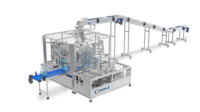5 Keys for Manufacturers and Brand Owners to Win with Sustainable Packaging

White kraftliner reels stacked in Metsä Board's Kemi Mill warehouse, Finland.
Image courtesy of Metsӓ Board
Trends come and go across many product categories, but when it comes to packaging, sustainability is steadily gaining momentum. From electronics to personal and beauty care, pharmaceuticals to food purchased both at retail or online, consumers of packaged goods are paying attention.
With world packaging demand reaching the $1 trillion amount for the first time in 2021, this is exactly the right time to think about what makes packaging more sustainable.
Manufacturers and brand owners can create more sustainable and responsible packaging solutions by focusing on:
1. Use Raw Materials Produced from Sustainable and Responsible Sources
Wood harvested from certified forests and paperboard created from this natural material is one of the only truly renewable sources for manufacturing fit-for-purpose, consumer packaging. Look for the PEFC, FSC®, or SFI certification logos printed on the package to ensure that sustainable and environmentally friendly forestry and re-forestation practices were used in obtaining wood for creating the paperboard material.
Recycled paperboards, while excellent in terms of preventing landfill waste, must be used in very specific applications. Keep in mind that fiber from recycled paperboards is untraceable and could have originated from unsustainably managed forests, or it can contain unknown residues of for example, printing inks, adhesives and lacquers.
Removing or reducing plastics and other fossil-based materials in packaging is high on the list when addressing sustainability. Plastics are predominantly made from oil, a non-renewable material with a harmful environmental impact both to produce and dispose of. Most plastics are not recycled and are inevitably bound for either the landfill or worse—they can wind up in our oceans. Once these products pollute the environment, they wreak havoc for a very, very long time… if not indefinitely.
2. Look at the way Packaging is Produced at its Source: The Mill
The process by which trees become pulp and then paper at a paperboard mill considerably influences environmental impact. Mills require significant amounts of energy to operate, and the less fossil-based fuels that are used during the process—the better. Some mills operate on energy created from byproducts of the trees, utilizing branches, twigs, needles, and bark in bioreactors. Reducing CO2 emissions and working towards being carbon neutral is also an important sustainability goal for a responsible paperboard producer. Clean water, like clean energy, is important, and when a mill is running more efficiently, more water can be recycled and reused within production, so less water is withdrawn from the environment. It is also essential that the mill only utilizes surface water to avoid depleting valuable groundwater resources and ensures that any water put back into the environment is even cleaner than when it was collected for use in the paper making process.
3. Find Solutions That Use Less Materials for Packaging
Smaller and more efficient structural design results in less paper used. If manufacturers and brand owners utilize lighter-weight paperboards while maintaining the structural integrity of the package, literally tons of paperboard can be saved—as well as associated costs by using less fiber material. So, it’s not only about reducing the size of the package, but also ensuring that the size of the press sheet is minimized. Strict focus should be applied at proper imposition, nesting, and minimizing the overall size of the sheet to reduce manufacturing waste. Any material reduction will also reduce shipping costs as well as CO2 emissions.
Removing or reducing plastic windows or trays is also a good practice, especially if products are primarily sold through e-commerce where the consumer is not looking at the package on shelf to see what’s inside. If it’s imperative to have a plastic component, it should be designed so that the plastic can easily be separated from the paperboard package to aid in consumer recycling. Recyclable plastics, such as PET, are preferable versus PVC. But more sustainable, plant-based plastics options such as PLA can also be explored.
For safety reasons, packaging for food, personal care, pharmaceuticals, etc. should avoid recycled fiber in favor of virgin fiber paperboards. Recycled paperboards can safely be used for items that are not applied to or ingested by humans, pets, or livestock. Virgin fiber plays an important role in the circular economy of packaging by adding strong fiber to fortify the recycled paperboard market. All materials used should be clearly identified as being “recyclable,” “biodegradable,” and “compostable” so that consumers know exactly what to do with them.
4. Ask Questions About the Manufacturing Process
Paper manufacturers should provide specific details about how they manufacture and produce paperboard. Find out where they stand in terms of overall business sustainability and what their EcoVadis or CDP score is. Start by requesting a sustainability report. The type of printing ink and associated production chemicals have an impact on the safety for food use, recycling, or composting.
Local, state, and federal legislation that reduces plastic waste, promotes increased recycling, and generally helps preserve natural resources such as our air, land, trees, water, etc., will also have an impact. For example, last year Oregon and Maine passed laws requiring packaging producers to help fund and organize the collection and processing of packaging, while 13 other states introduced similar legislation. This is called extended producer responsibility and is an established norm in Europe and Canada.
5. Clearly Communicate What You Are Doing
Finally, taking everything above into consideration is just the start of demonstrating your commitment to sustainability. The other important piece is communicating the steps you’re taking. Get involved in certification programs and be sure to print your compliancy logos on your package, such as FSC, PEFC, SFI and recycling logos. Place this information as well as your sustainable supplier commitment on your website or printed in your instruction sheets within the package. Speak about it in ad campaigns, industry journals, or blogs. Take the steps, be committed, be transparent and your consumers will see it in your packaging.
Looking for a reprint of this article?
From high-res PDFs to custom plaques, order your copy today!






